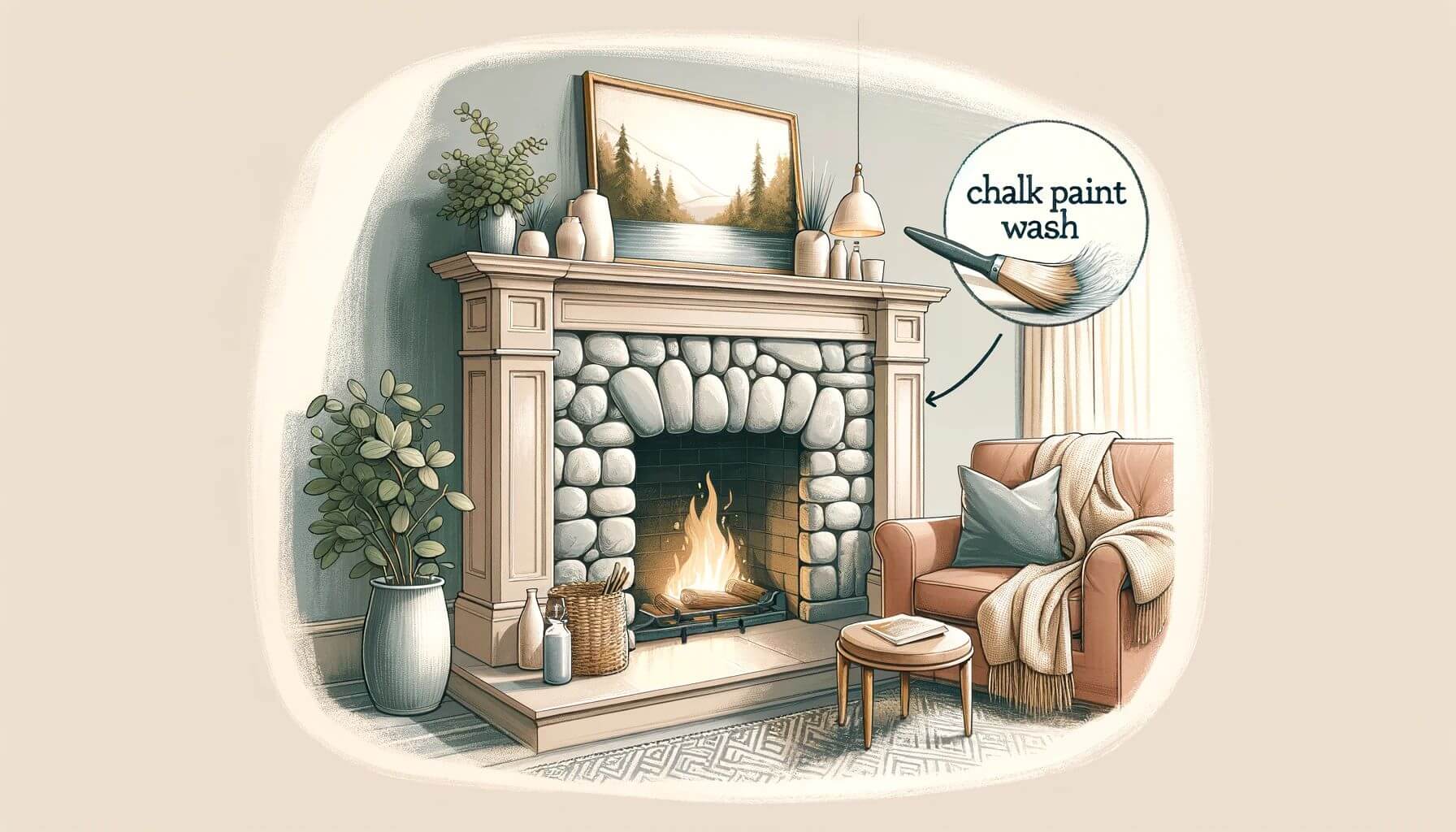
To whitewash stone fireplace is a simple yet effective way to brighten your living space while maintaining its natural charm. This technique lightens up the room and adds a modern twist to your decor. In this guide, we’ll explore 30 diverse whitewashing techniques, suitable for both novices and seasoned DIY enthusiasts. Get ready to transform your whitewashed stone fireplace into a stunning focal point of your home.
1. Classic Whitewash
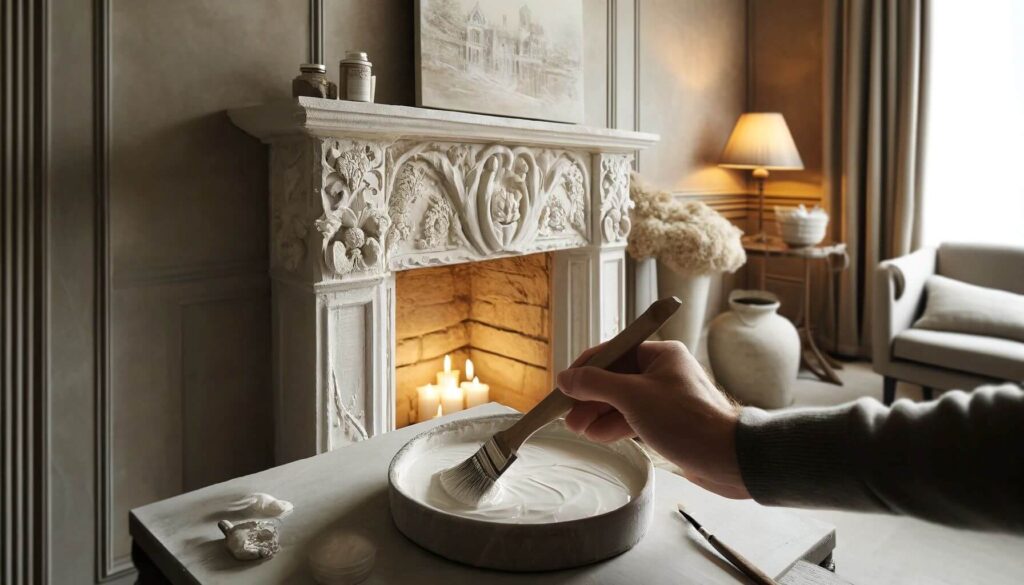
- Materials Needed: Latex paint (white), water.
- Method: Begin by mixing two parts of white latex paint with one part water; this will create a thin, washable paint. Use a brush to apply this mixture to your whitewashed rock fireplace. Be sure to brush in a manner that lets the natural texture of the stone fireplace show through. The thinness of the paint will allow the color and texture of the stone whitewash to blend subtly with the whitewash, giving a refreshed yet natural appearance.
2. German Schmear Technique on a Stone Fireplace
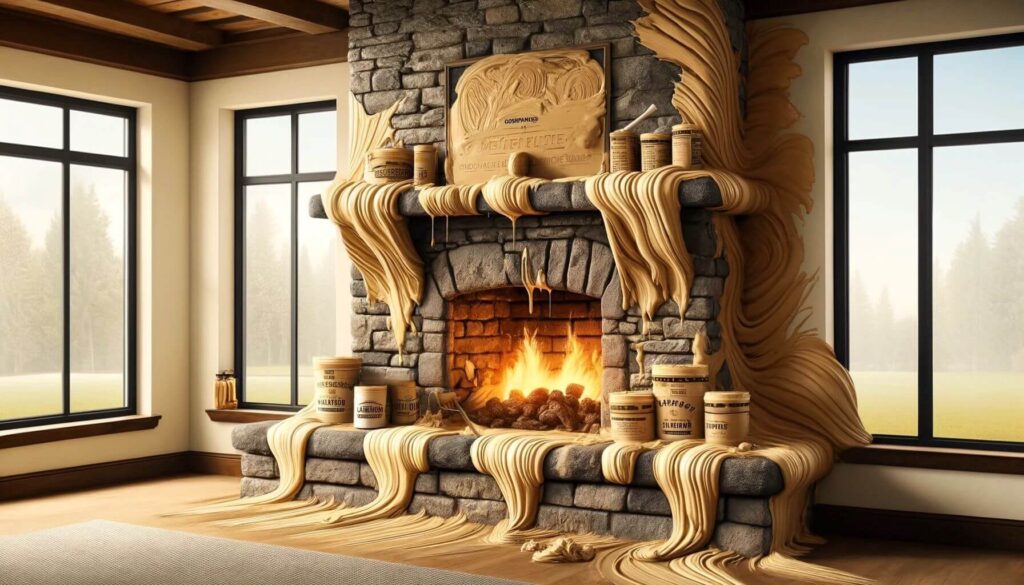
- Materials Needed: Mortar mix, water, sponge.
- Method: Mix the mortar with water until you achieve a consistency similar to peanut butter. Apply this mixture generously over the stones with a trowel or by hand. Before the mortar sets, take a sponge and lightly wipe over the surface, focusing particularly on the joints. The goal is to fill the joints and pull the mortar partially off the face of the stones, creating a rugged, textured look. This technique is great for achieving a rustic, old-world feel on a german schmear rock fireplace.
3. Limewash Stone Fireplace Technique
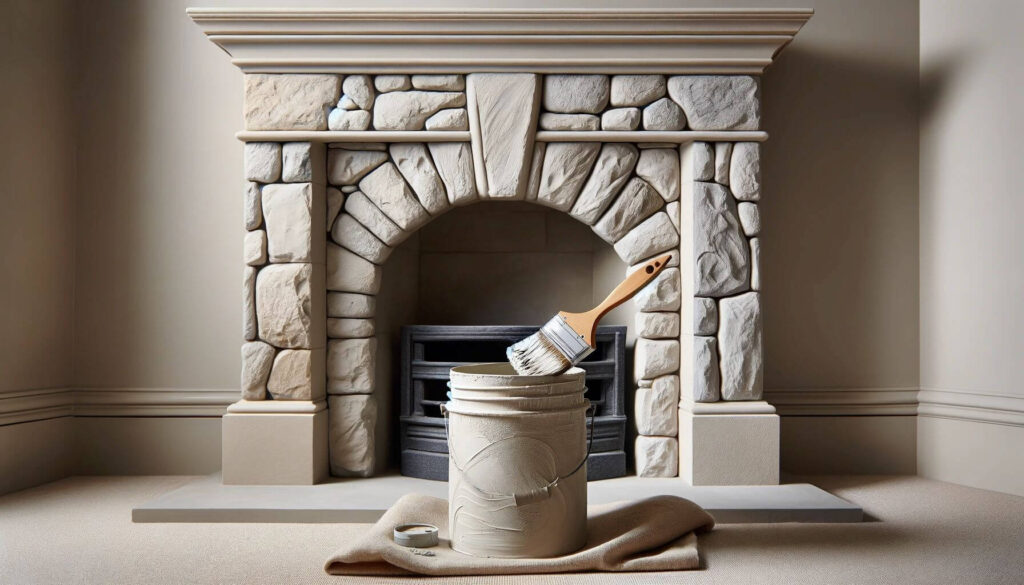
- Materials Needed: Hydrated lime, water, salt.
- Method: To prepare the limewash, mix hydrated lime with water and a small amount of salt to form a paint-like solution. This mixture should be more fluid than traditional paint to ensure it deeply penetrates the porous stone, which helps to seal the surface while also providing a durable finish. Apply the limewash with a brush in even strokes. Limewashed stone fireplace before and after images can show how this technique ages beautifully over time.
4. Gray Wash
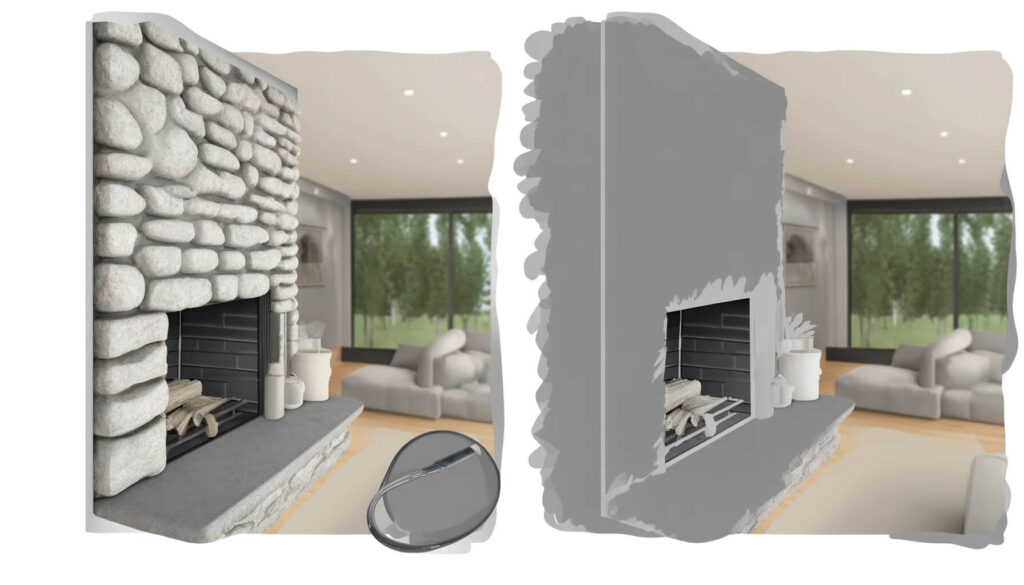
- Materials Needed: Gray latex paint, water.
- Method: This method follows the same basic principles as the classic whitewash but substitutes white paint with gray. Combine two parts of gray latex paint with one part water to create a wash that is both thin and spreadable. Apply this mixture with a brush, allowing the natural stone texture to subtly show through. The gray tone provides a softer contrast than white, subtly lightening the grey washed stone fireplace while maintaining the ruggedness of the stone.
5. Color Wash

- Materials Needed: Latex paint in desired color, water.
- Method: Choose a color that complements your room’s decor and mix it with water in equal parts to create a thin paint. Apply this stone whitewash lightly over the stones with a brush, using smooth, even strokes that let the original stone color mingle with your chosen hue. This technique is perfect for adding a custom splash of color while softening the overall look of your fireplace.
6. Sponge Wash
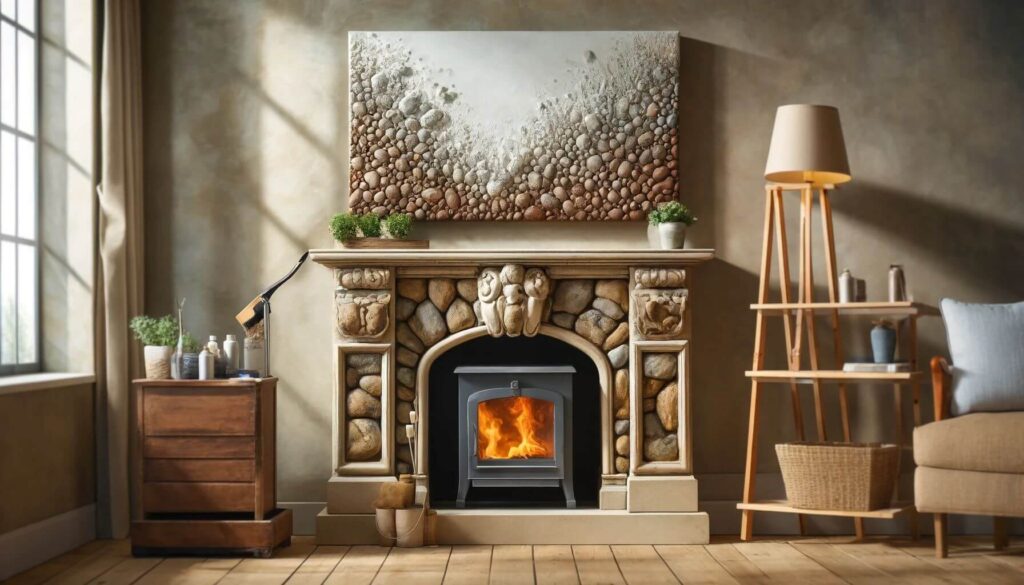
- Materials Needed: Latex paint, water, sponge.
- Method: Prepare a diluted paint solution by mixing latex paint with water at a 1:1 ratio. Dip a sponge into this mixture and then lightly dab it onto the stone surface. The sponge’s texture helps create a unique, mottled effect that can mimic natural variations in color and texture. This method is ideal for achieving a more nuanced, textured look for your whitewashed stone fireplace.
7. Dry Brushing To Whitewash Stone Fireplace
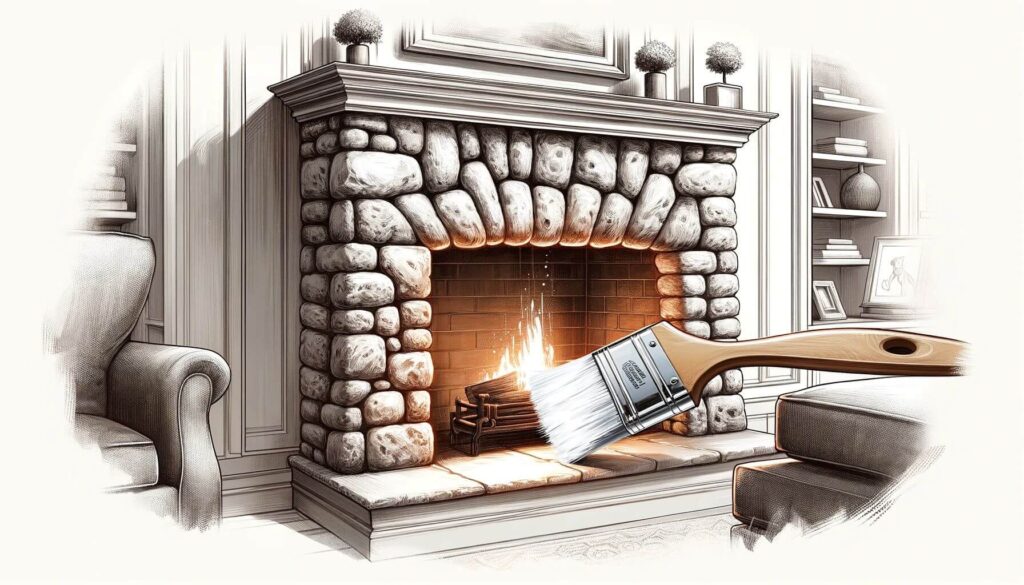
- Materials Needed: White latex paint, dry paintbrush.
- Method: This whitewashing technique involves lightly dipping a dry paintbrush in white latex paint, then gently brushing over the stones. The key is to use very little paint and not to saturate the brush, this will highlight the natural edges and textures of the stone without covering them up completely. Dry brushing is perfect for adding subtle highlights and creating a worn, naturally weathered look.
8. Wipe Off Method
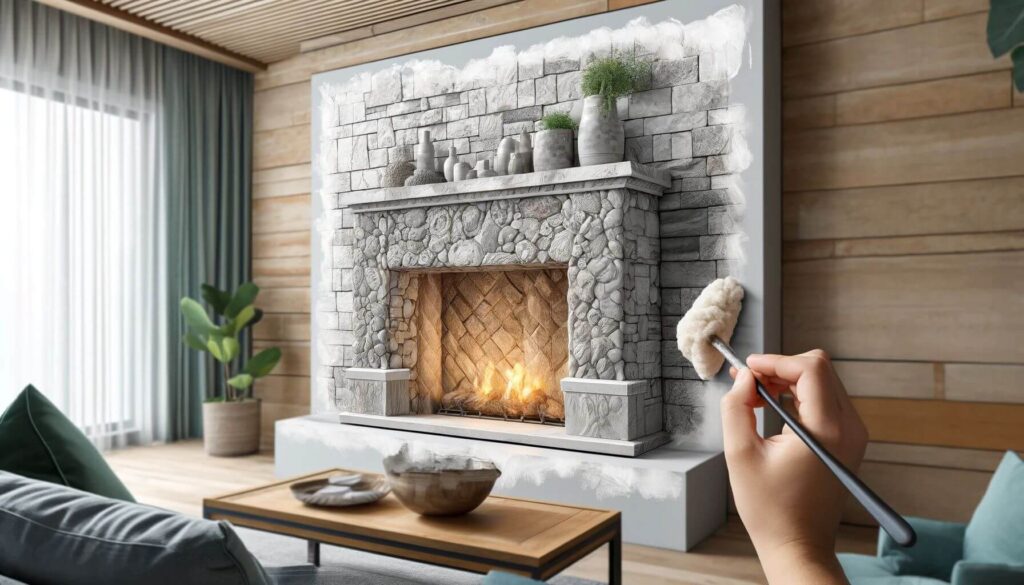
- Materials Needed: White wash mixture (white latex paint thinned with water), cloths.
- Method: Apply a generous amount of white wash over the stones using a brush. While the wash is still wet, take a cloth and begin to wipe off the paint in areas where you want to reduce the intensity. This method allows you to create a varied visual texture across the fireplace, perfect for a whitewashed rock fireplace.
9. Layered Wash
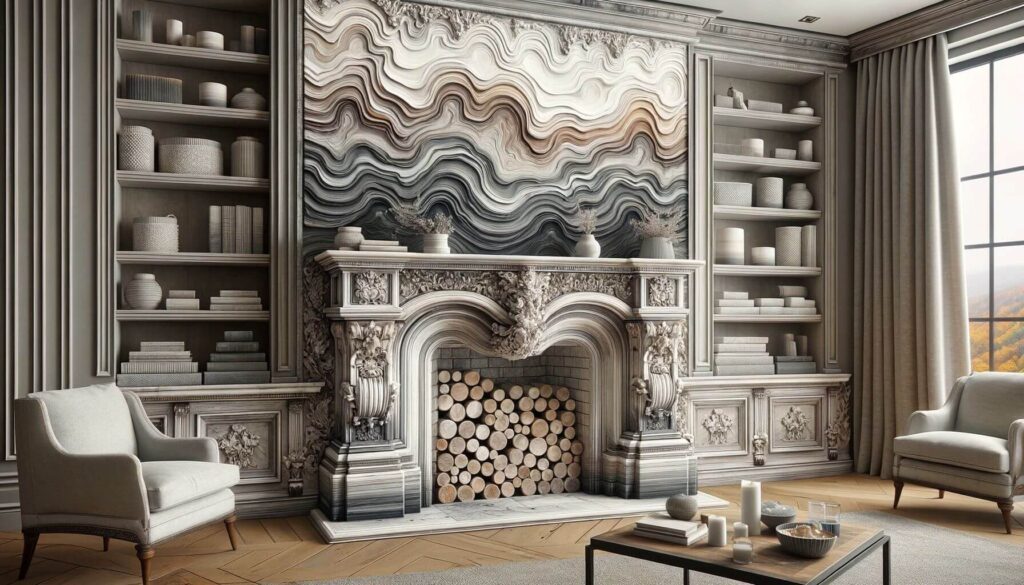
- Materials Needed: Multiple shades of paint (white, gray), water.
- Method: Start by applying a base coat of one color, such as gray, diluted with water. Allow this layer to dry completely. Next, apply a second coat of a different color, such as white, also diluted. While the second coat is still wet, selectively wipe away areas of the white paint to expose the underlayer of gray. This whitewashed stone fireplace technique adds depth and a custom, artisanal quality to the stone’s appearance.
10. Stenciling Over Stone
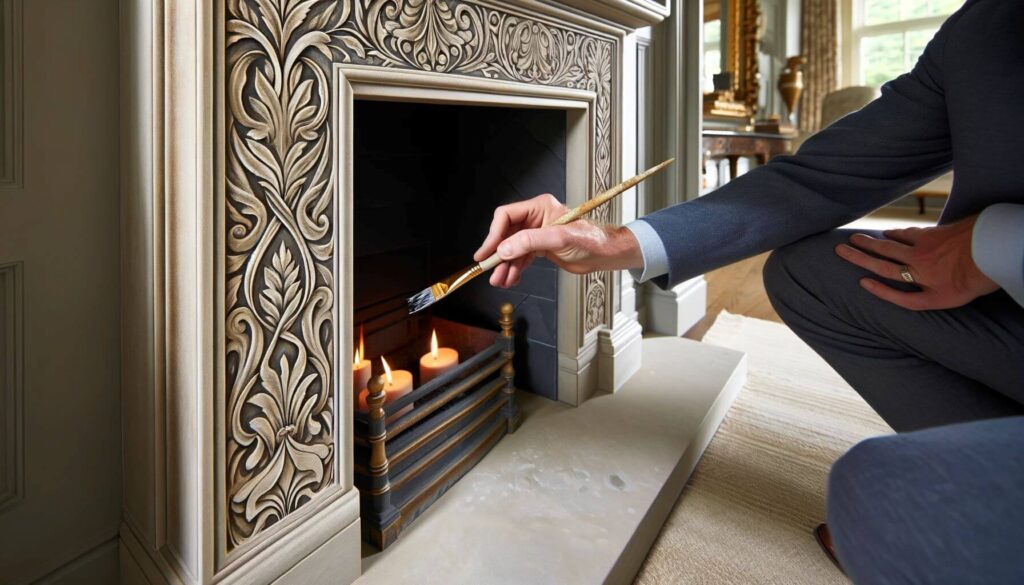
- Materials Needed: Stencil, stenciling brush, thinned paint.
- Method: Choose a stencil that complements your room’s style, whether geometric, floral, or abstract. Secure the stencil over the stone area you wish to decorate. Use a stenciling brush to apply thinned paint over the stencil. Carefully remove the stencil to reveal the design. This method adds a decorative touch to your whitewashed stone fireplace.
11. Whitewash Over Sealant
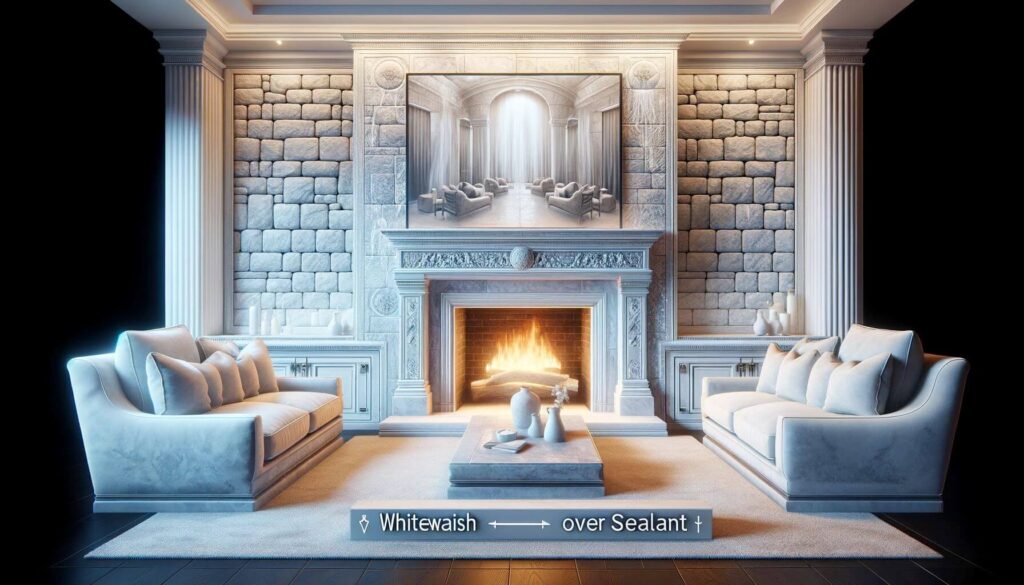
- Materials Needed: Stone sealant, whitewash mixture.
- Method: First, apply a stone sealant over the clean stones of your fireplace and allow it to dry completely. This sealant acts as a barrier to prevent too much whitewash absorption, which can be particularly useful on very porous stones. After the sealant has dried, apply your whitewash stone fireplace mixture as normal. This whitewash stone fireplace technique ensures a more uniform whitewash and can help highlight the stone’s natural hues while protecting them against soot and heat damage.
12. Dipped Look Technique
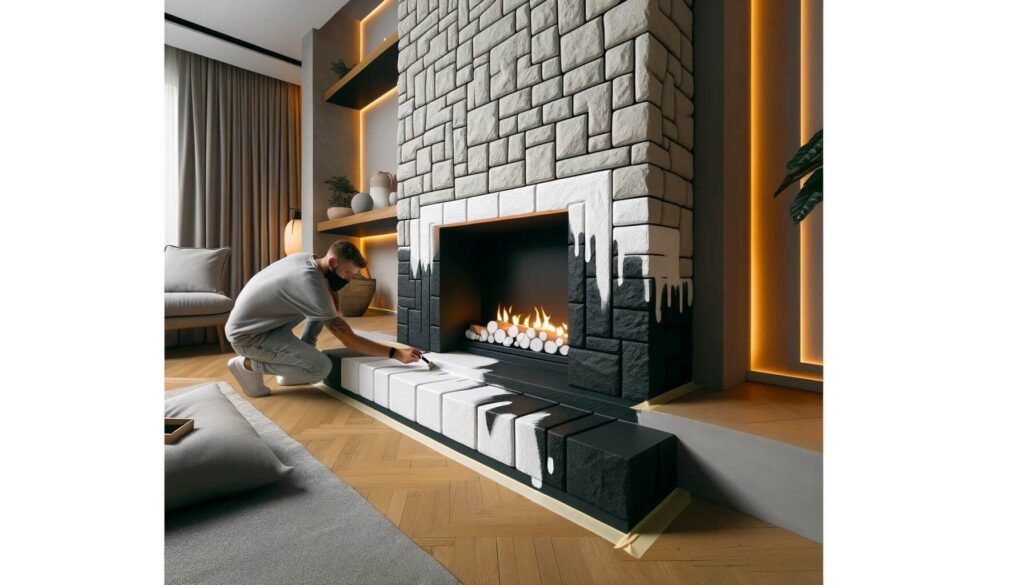
- Materials Needed: White latex paint, water, painter’s tape.
- Method: This visually striking method involves creating a sharp, horizontal line that gives the effect of the bottom half of the whitewashed rock fireplace being dipped in paint. Use painter’s tape to mark a straight line around the fireplace at the height you desire. Mix a thicker whitewash (less water, more paint) and apply it below the tape line, making sure to cover thoroughly for a solid look. Once dry, remove the tape to reveal a clean, crisp line. This dipped effect is modern and chic, perfect for adding a contemporary edge to your room.
13. Antique Glaze

- Materials Needed: Whitewash mixture, antique glaze.
- Method: Start by applying a standard whitewash mixture to your clean, dry stones. Allow this base layer to completely dry. Then, apply an antique glaze over the whitewash. Use a soft cloth or brush to work the glaze into the nooks and crannies of the stone, enhancing the texture and adding a layer of depth. This method will darken the recesses, giving your limewashed stone fireplace a seasoned, vintage look.
14. Two-Tone Contrast
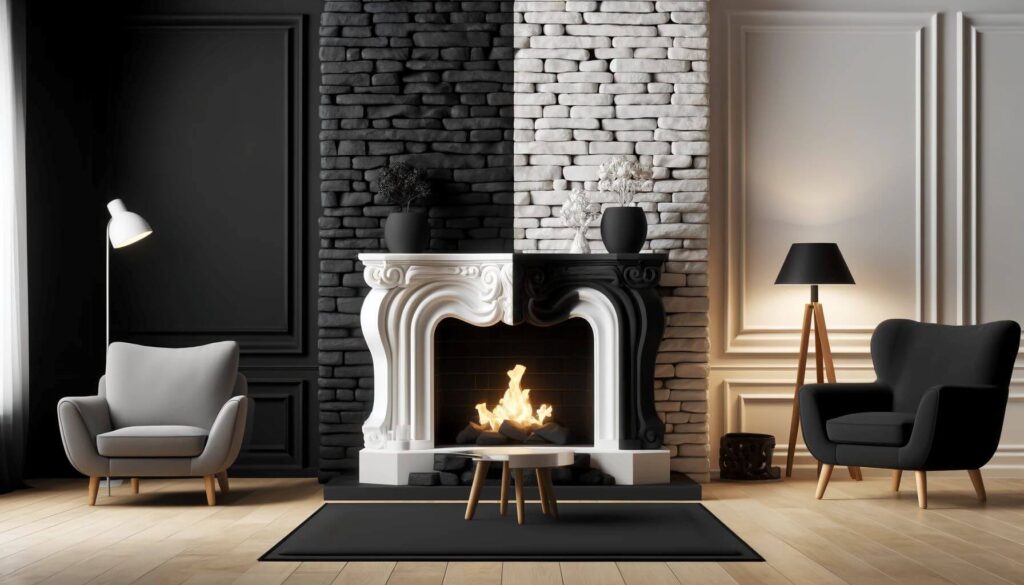
- Materials Needed: Two contrasting colors of paint (e.g., white and black), water.
- Method: Apply the darker color (such as black) as a base coat over the entire surface of the stones. Let this coat dry thoroughly. Next, prepare a lighter color whitewash (such as white) and lightly brush it over the base coat. This black wash stone fireplace method allows the base color to show through slightly, creating a striking two-tone effect.
15. Natural Brush Whitewash
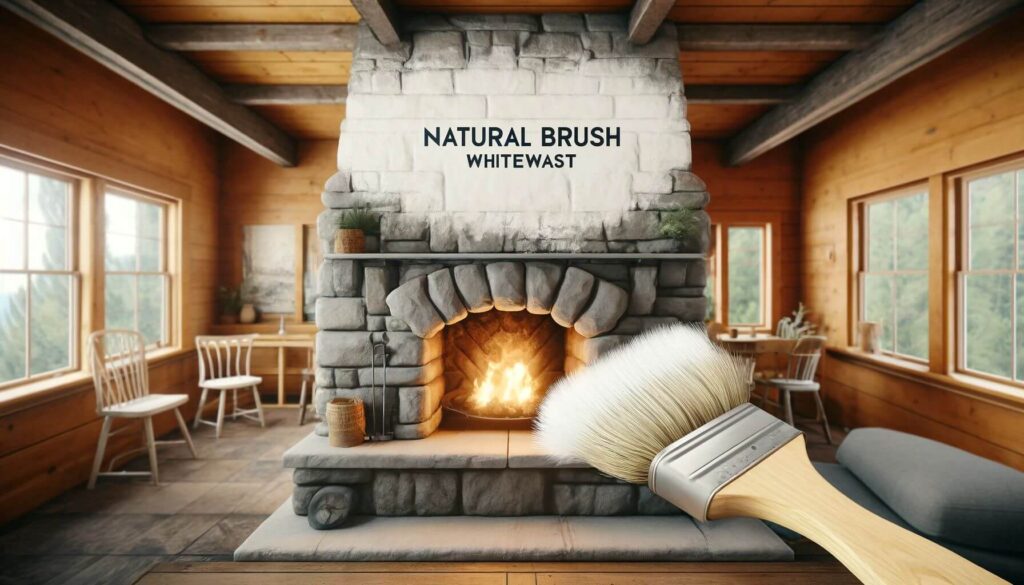
- Materials Needed: Large natural bristle brush, whitewash mixture.
- Method: Dip a large, natural bristle brush into your whitewash mixture. Apply it unevenly across the stones of your fireplace. The bristles’ natural stiffness and irregularities make it easier to achieve a varied, textured look. This technique for how to whitewash stone fireplace is ideal for achieving a more rustic effect.
16. Textured Whitewash Technique
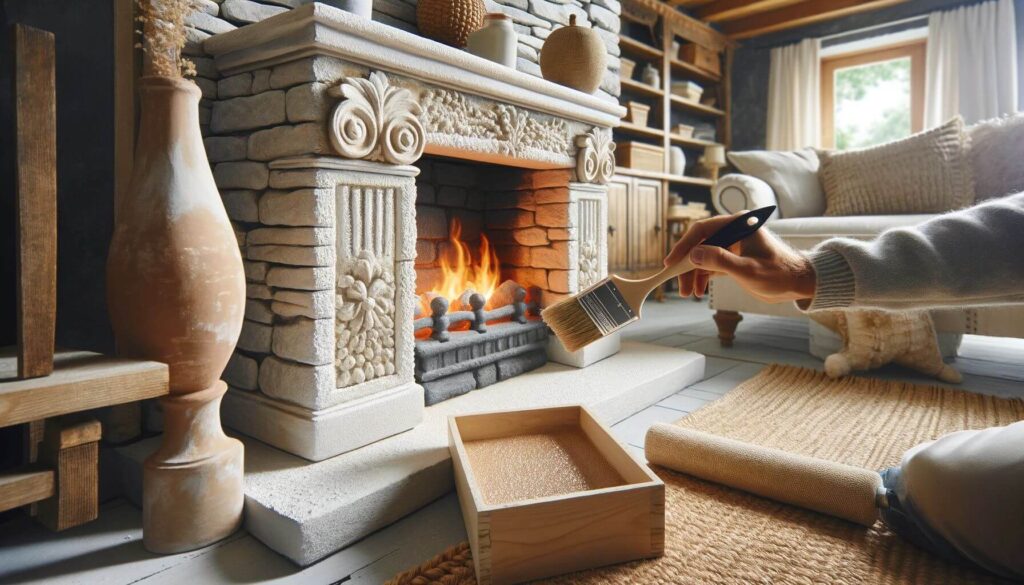
- Materials Needed: Textured paint, brush or roller.
- Method: Opt for textured paint, which typically contains fine sand or grains, to add a tactile quality to your whitewash. Apply the paint using a brush or roller, depending on the size of the area and the desired graininess of the finish. This technique is perfect for those looking to enhance their whitewashed stone fireplace with additional depth.
17. Fireplace Upgrade with Chalk Paint Wash

- Materials Needed: Chalk paint, water.
- Method: Dilute chalk paint with three parts water to one part paint to create a wash that maintains the paint’s velvety, matte finish. Apply this wash with a brush, using long, even strokes that let the paint settle into the natural crevices of the stone. Chalk paint’s unique texture gives your whitewashed fireplace stone a cozy, vintage feel.
18. Tinted Limewash

- Materials Needed: Hydrated lime, water, tinting pigment.
- Method: Start by mixing hydrated lime with water to create a base limewash. Add tinting pigment to this base to achieve the desired color intensity. Apply the limewash stone fireplace in multiple thin coats, allowing each coat to dry thoroughly before applying the next. This builds up a depth of color and texture that beautifies the stone. It will protects it by penetrating deeply and sealing the porous surface.
19. Beeswax Finish
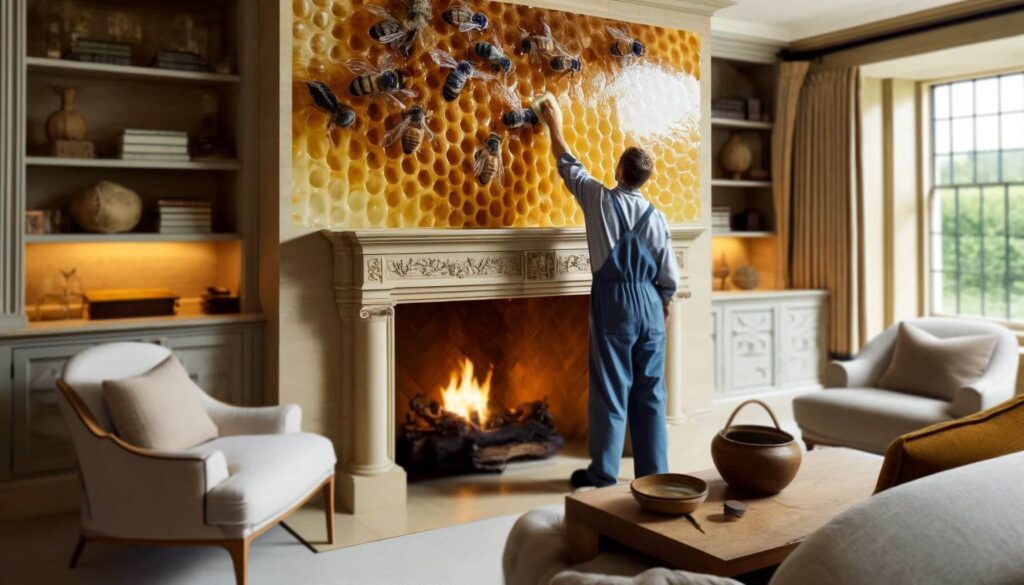
- Materials Needed: Beeswax, cloth, whitewash.
- Method: First, apply your chosen whitewash to the whitewash painted stone fireplace and allow it to dry completely. Next, take a piece of cloth and use it to rub beeswax over the surface of the stones. Buff the stones with the cloth until they shine slightly. This finish will deepen the natural color of the stones. Also it provides a protective coating that strengthen their durability and appearance.
20. Venetian Plaster Technique
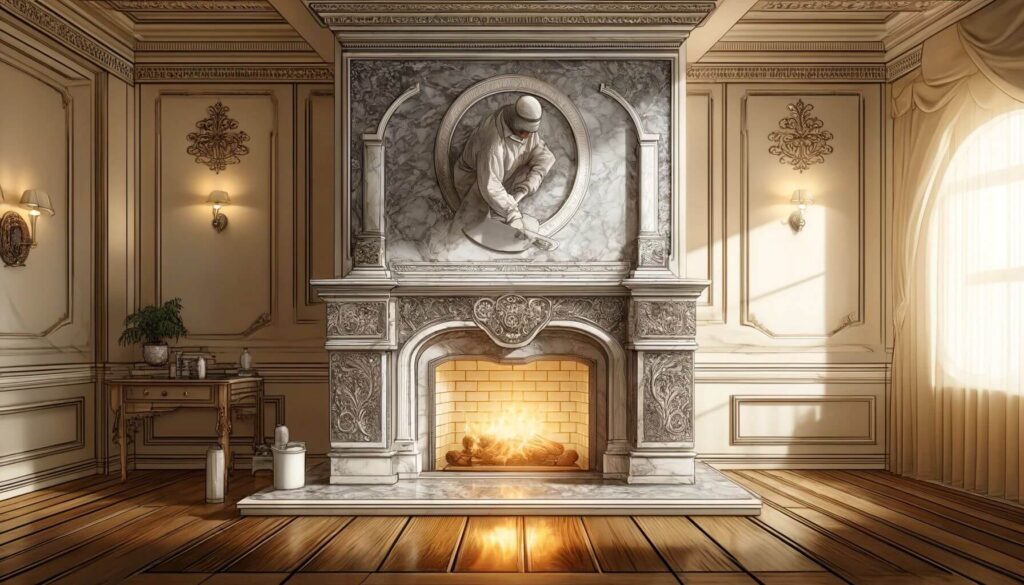
- Materials Needed: Venetian plaster, trowel, burnishing tool.
- Method: Apply Venetian plaster to the stone surface using a trowel. Work in small sections to ensure an even coat. After the plaster has been applied, use a burnishing tool to polish the surface until it is smooth and has a high-gloss finish. This technique can mimic the look of polished marble, giving your limewashed stone fireplace a luxurious touch.
21. Acid Wash
- Materials Needed: Muriatic acid, water, protective gear (gloves, goggles, respirator).
- Method: Protect yourself with appropriate gear before starting. Mix a solution of muriatic acid and water, following the manufacturer’s directions for the appropriate ratios. Carefully apply this solution to the stone surface to etch it slightly, which will help the whitewash adhere better and increase the natural textures. This method works well for preparing a whitewashed stone fireplace. Rinse the stone thoroughly with water after applying the acid wash, and allow it to dry completely before applying whitewash.
22. Wax Resist
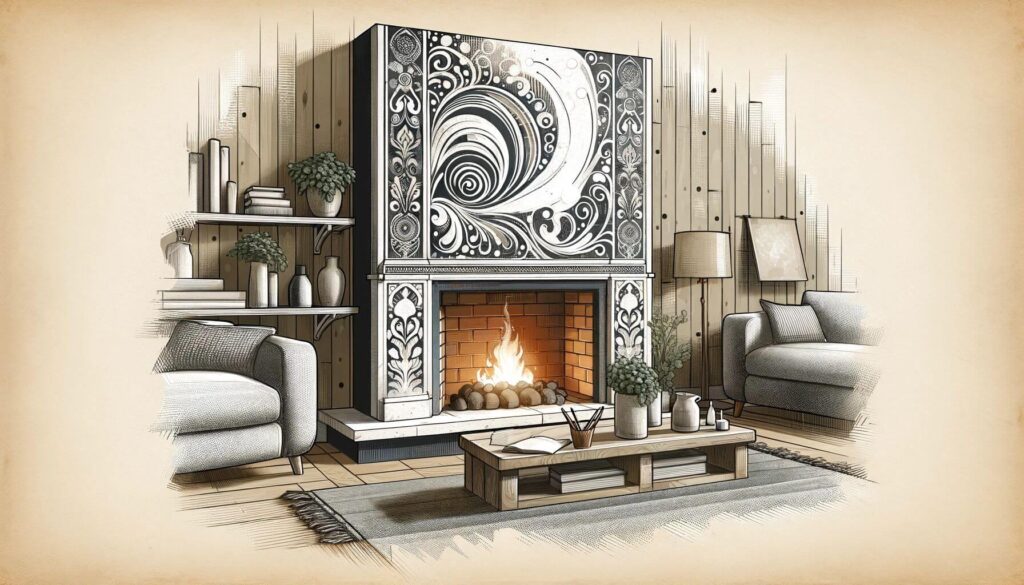
- Materials Needed: Water-based wax, whitewash mixture.
- Method: Begin by applying water-based wax on specific areas of the stone where you prefer to keep the original darker color visible. Once the wax is set, apply a layer of whitewash over the entire surface. The wax will repel the whitewash on the areas it covers, creating a two-tone effect on your stone whitewashed fireplace.
23. Sand Blasting
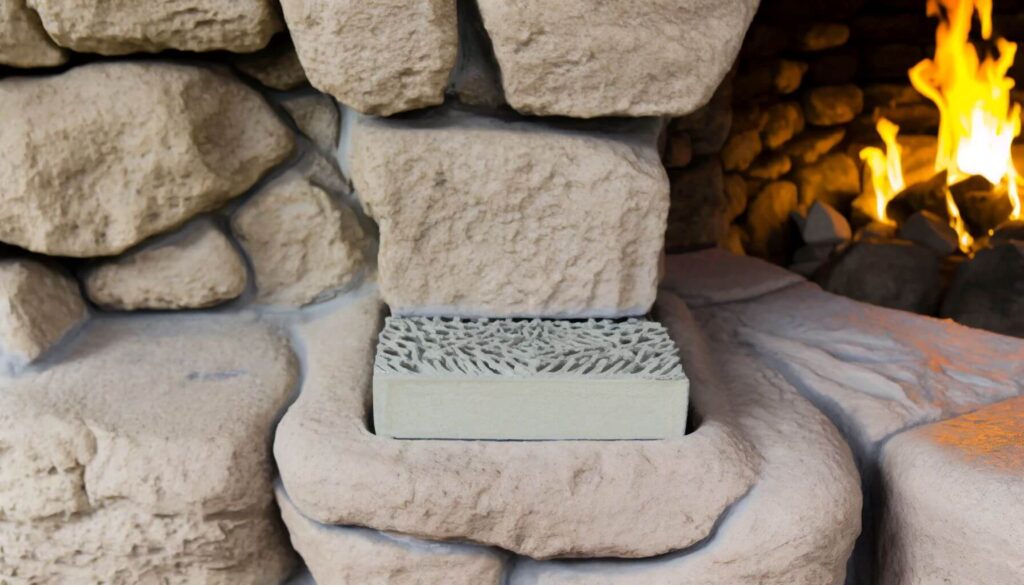
- Materials Needed: Sandblaster, protective gear (such as gloves, goggles, and a respirator).
- Method: Before you start, ensure you are wearing appropriate protective gear. Use a sandblaster to carefully roughen the surface of the stones. This texturizing process will clean the stone thoroughly and improve the adherence of the whitewash, resulting in a long-lasting finish for your whitewashed stone fireplace. This method is particularly effective for achieving a consistent, professional-quality surface for whitewashing.
24. Sea Sponge Effect
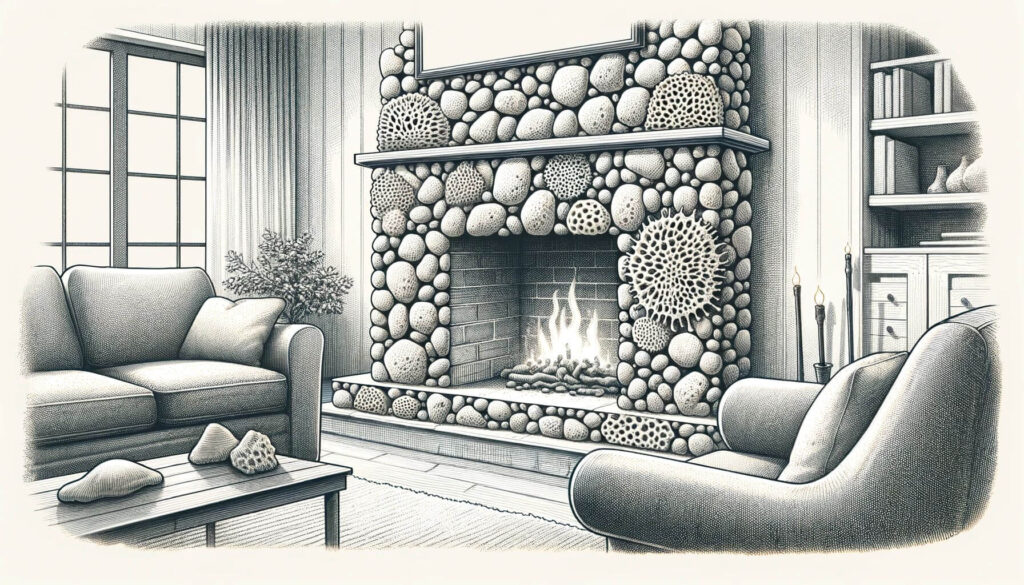
- Materials Needed: Sea sponge, whitewash mixture.
- Method: Dip a sea sponge into the prepared whitewash mixture. Press the sponge gently onto the stones, using a dabbing motion to create an uneven, textured look. The natural irregularities of the sea sponge help mimic wear and weathering, adding depth and interest to your whitewashed stone fireplace. This method is ideal for those looking to achieve a more nuanced and visually interesting finish.
25. Faux Finish Granite Technique

- Materials Needed: Dark gray base coat, sponges, white and black glaze.
- Method: Start by applying a dark gray base coat to the entire surface of the stones, ensuring it is completely dry before proceeding. Once dry, take a sponge and lightly dab on white and black glaze to create a speckled, granite-like effect. This technique provides a sophisticated look to your dark grey wash stone fireplace.
26. Roller Texture
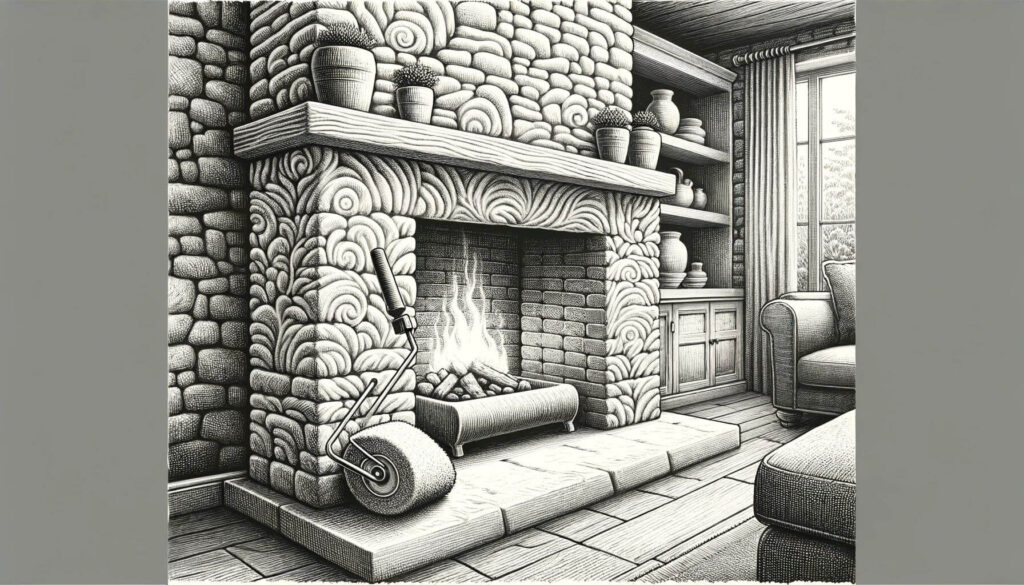
- Materials Needed: Thick-nap roller, diluted whitewash.
- Method: Prepare a diluted whitewash mixture, typically thinner than what you would use for a standard application. Use a thick-nap roller to apply the whitewash across the stones. The thick nap of the roller creates a textured, uneven finish, enhancing the appearance of your whitewashed stone fireplace. This method is perfect for adding depth and a tactile quality that magnify the fireplace’s overall aesthetic.
27. Splatter Technique to Update Fireplace
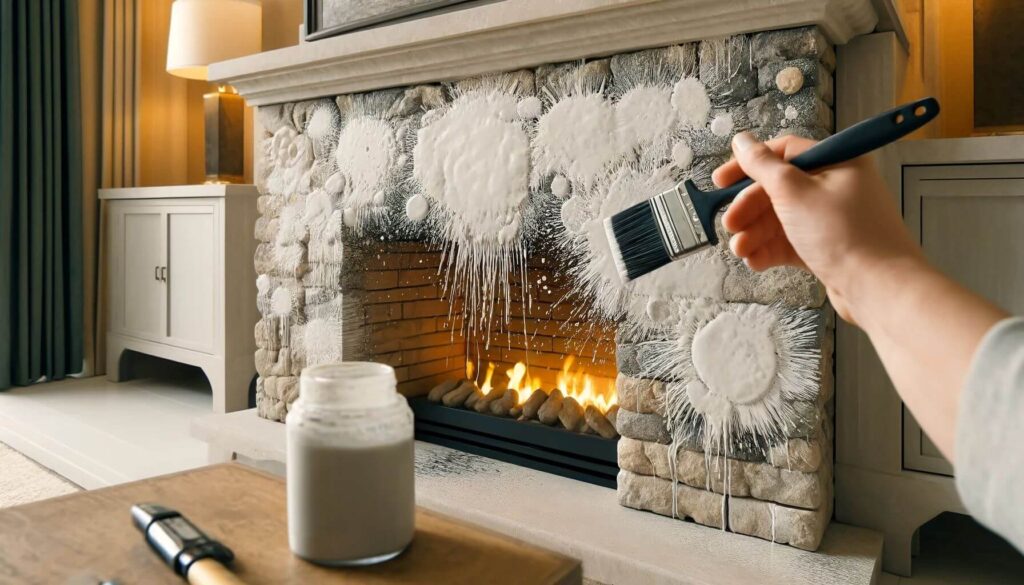
- Materials Needed: Toothbrush or stiff brush, whitewash mixture.
- Method: Dip a toothbrush or a stiff-bristled brush into the whitewash mixture. Hold the brush over the stones and flick the bristles using your finger, causing the whitewash to splatter across the surface. This creates a random, splattered effect, adding a playful touch to the whitewashed stone fireplace.
28. Ombre Whitewash

- Materials Needed: Several shades of whitewash.
- Method: Begin by preparing multiple shades of whitewash, ranging from dark to light. Start applying the darkest shade at the bottom of your fireplace. Start applying the darkest shade at the bottom of your whitewashed rock fireplace and gradually transition to lighter shades as you move upwards. This technique creates a gradient or ombre effect. This whitewash stone fireplace technique draws the eye upwards and makes the fireplace a dramatic focal point of the room.
29. Mineral-Based Paint Whitewash Stone Fireplace
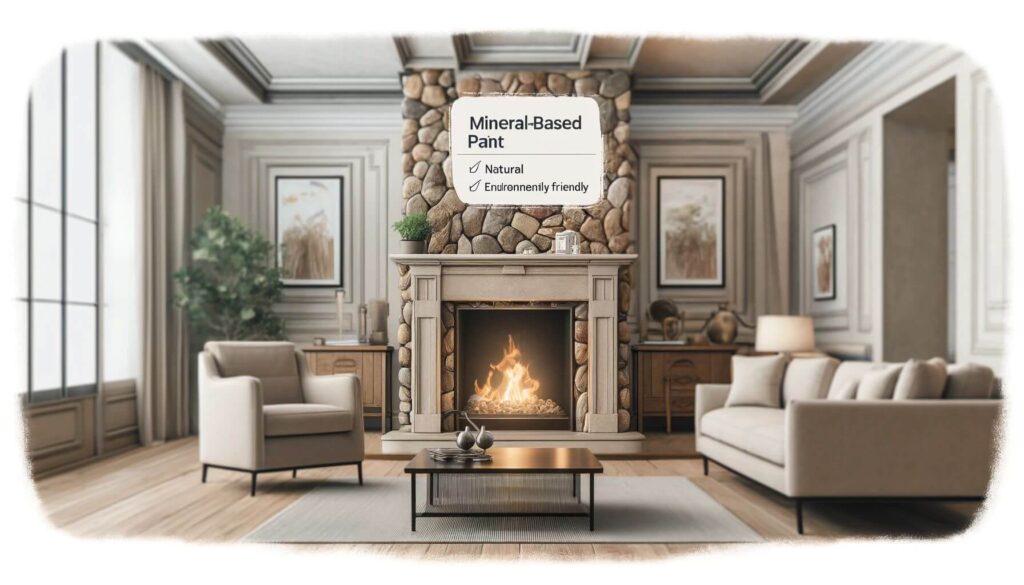
- Materials Needed: Mineral-based paint, brush.
- Method: Opt for mineral-based paint, which is renowned for its natural composition and environmental friendliness. Apply this paint using a standard brush technique. Mineral paints are highly adhesive and will protect your whitewashed stone fireplace from fading. They also resist fading and aging, ensuring that your fireplace maintains its color and finish over time without the harmful chemicals typically found in traditional paints.
30. Distressed Whitewash
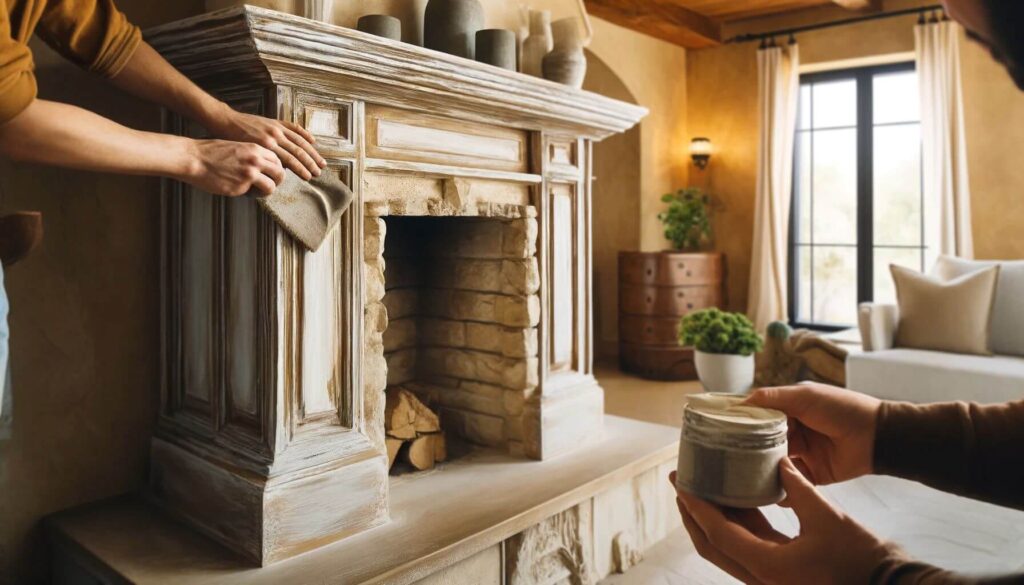
- Materials Needed: Sandpaper, whitewash mixture.
- Method: Apply a layer of whitewash to the stone as you would with a basic whitewashing method. Once the whitewash has dried, take a piece of sandpaper and gently sand various areas of the fireplace. Focus on edges, corners, and other spots where wear might naturally occur. This technique gives your whitewashed stone fireplace a worn, distressed look. This sanding will partially remove the whitewash, creating a worn, distressed look that adds plenty of characters and rustic charm to your fireplace.
How to Modernize Stone Fireplace with Whitewashing
A whitewashed stone fireplace can transform your living space into a bright and welcoming area. With the 30 techniques outlined above, from simple classics like the basic whitewash stone fireplace to more intricate methods such as the ombre effect and distressed looks, you have a wide array of options at your disposal to refresh and beautify your fireplace. Each method to modernize old fireplace will boost the aesthetic of your room but also allows you to infuse your personal style into a central piece of your home décor.
Whether you prefer a subtle, clean finish or a dramatic, eye-catching design, whitewashing a stone fireplace is a versatile and cost-effective solution. It’s a perfect weekend project that can update the look of your living space while showcasing the natural beauty of the stone. So grab your supplies, choose your technique, and give your whitewashed stone fireplace a stunning makeover.



